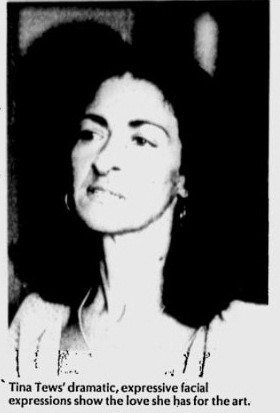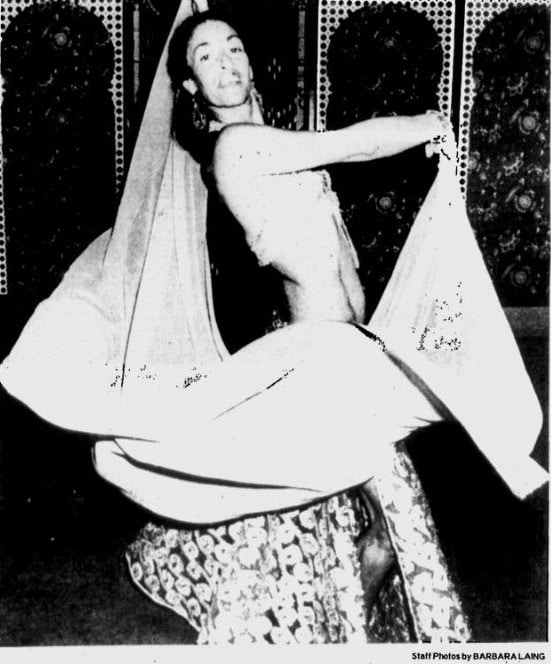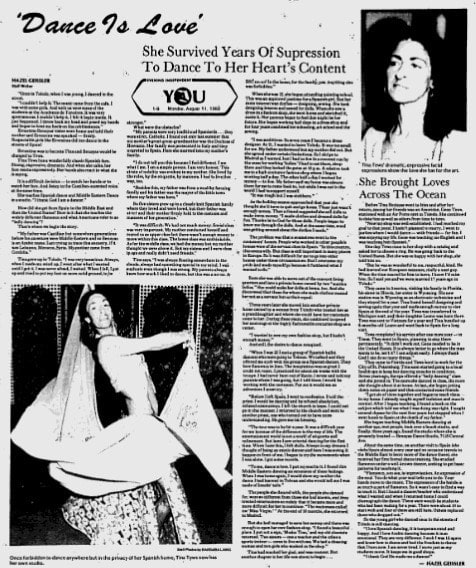She Survived Years Of Supression
To Dance To Her Heart’s Content
By HAZEL GEISSLER – Staff Writer for the Evening Independent
August 11,1980
 “Once in Toledo, when I was young, I danced in the street. “I couldn’t help it. The music came from the cafe. I was with some girls. And with us were some of the students at the Academic de Toredors. It was very spontaneous. I couldn’t help it. I felt it begin inside. It just happened. I threw back my head and posed my hands and began to hit my heels on the cobblestones.”
“Once in Toledo, when I was young, I danced in the street. “I couldn’t help it. The music came from the cafe. I was with some girls. And with us were some of the students at the Academic de Toredors. It was very spontaneous. I couldn’t help it. I felt it begin inside. It just happened. I threw back my head and posed my hands and began to hit my heels on the cobblestones.”
Ernestine Benayas sister went home and told their mother and Ernestina was spanked — firmly.
Respectable girls like Ernestina did not dance in the streets of Spain!
Ernestina was to become Tina Benayas, and later Tina Tews.
Tina has a wonderfully classic Spanish face. Strong, expressive, dramatic. And when she talks, her face reacts expressively. Her hands also react to what she is saying. It is a difficult decision—to watch her hands or to watch her face, and listen to the Castilian accented voice at the same time. She teaches Spanish dance and Middle Eastern Dance in her studio. “I thank God I am a dancer.”
How did she get from Spain to the Middle East and then the United States? How is it that she teaches both flamenco and what Americans refer to as “belly dancing”?
That’s where we begin the story.
“My father was Castilian but generations before his ancestors were Middle Eastern and so Benayas is an Arabic name. l am trying to trace this ancestry. Not sure if it was from Lebanon, Morocco or Syria. My mother came from Cordoba, Spain.”
Tina grew up in Toledo. “I was very tenacious. When I made my mind up, I went after what I wanted until I got it. I was never afraid. When I fell, I got up and tried to put my foot on more solid ground.

“My parents were very traditional Spaniards … they were strict Catholics. I found out only last summer that my mother’s great-great grandmother was the Duchess of Bravante. Her family was persecuted in Italy and they migrated to Spain. There she married into my mother’s family. “I do not tell you this because I feel different. I am who I am. I am a simple person. I am very honest. This strain of nobility was evident in my mother. She lived by the rules, etiquette, and strict manners. I had to live this way too. “Besides this, my father was from a wealthy farming family and his father was the mayor of the little town where my father was born.”
So five sisters grew up in a closely knit Spanish family where they loved and were loved, but their father was strict and their mother firmly held to the customs and
manners of her generation.
“It was difficult. We did not have much money. Social class was very important. My mother conducted herself and reared us as upper class, but there wasn’t enough money to be in this class. The lower class was unthinkable. As for the middle class, we had the money but my mother thought we were above it. But my sisters and I were close in age and really didn’t need friends.”
Tina says, “My mind was always floating somewhere in the clouds, always had something special in my mind. I was an idealist even though I was strong. My parents always knew how much I liked to dance, but this was a no-no. A BIG no-no. Within the home, for the family, dancing was allowed, anything else was forbidden.”
When she was 12, she began attending painting art school. This was an approved pastime for a Spanish girl. But her main interest was clothes — designing and sewing. She took designing lessons and sewed clothing for dolls. When she saw a dress in a fashion shop, she went home sketched it, and made it. Her parents began to feel this might be her future. She began working half days in a dress shop for four years combined her schooling, art school and sewing.
“I was ambitious. In seven years I became a dress designer. At 21, I wanted to leave Toledo. It was too small for me. My father understood, but my mother did not. She eventually agreed under certain limitations. So I went to Madrid as I wanted, but I had to live in a convent run by nuns for working ladies! I had to eat there, sleep there and they locked the gates at 10 p.m. A relative took me to a high courtier fashion shop where I began working half days as an apprentice. The other half day I worked for money to live on. My father said my home was always there for me to come back to, but while I was out in the world I had to support myself. It was rough but I was stubborn.”
As the holiday season approached that year she thought she’d have to quit and go home. There just wasn’t enough money. Then a friend suggested she sell dolls to make extra money. “I made clothes and dressed dolls for fun. Thank God for those dolls. People began to know me for my hand made dolls. And at the same time, word was getting out about the clothes I made.”
The problem was that a seamstress went to clients homes. People who worked in other people’s homes were considered servant class in Spain. “In this country, this seems silly. But class was still important in many places in Europe. So it was difficult for me to go into other people’s homes under these circumstances. But I overcame my pride and made myself go because it furthered what I wanted to do.”
Soon she was able to move out of the convent living quarters and into a private home owned by two “maiden ladies.” She could make her dolls at home, too. And she discovered that those for whom she mode clothes treated her not as a servant but as their equal.
Three years later she moved into another private home owned by a woman from Toledo who treated her as a granddaughter and where she could have her customers come to her. During these years, she continued to spend her mornings at the highly fashionable couturier shop as a cutter. “I wanted to own my own shop, but there was not enough money.”
And still, the desire to dance remained.
When I was 23, I meta group of Spanish ballet dancers who were going to Tehran. We talked and they offered me a job with the group as a Spanish dancer. They love flamenco in Iran. The temptation was so great I could not resist. I practiced for about six weeks with the troupe. I had never been out of Spain. I wrote and told my parents where I was going, but I told them I would be working with the costumes. For me it would me an adventure I must try.
“Before I left Spain, I went to confession. I told the priest I would be dancing and he refused absolution, refused communion. I left the church in tears. I could not go in this manner. I returned to the church and went to another priest, one who turned out to have more understanding. He gave me his blessing.”
“The tour was to be for a year. It was a difficult year for me because of the different way of life. The entertainment world is not a world of etiquette and refinement. But here I saw Middle Eastern dancing for the first time. When I saw this, I felt chills. Always in my dreams I thought of being an exotic dancer and here I was seeing it happen in front of me. I began to try the movements when I was alone.”
“To me, dance is love. I put my soul in it. I found this Middle Eastern dancing an extension of these feelings. When I was home again, I would show my mother the dance I had learned in Tehran and she would tell me I was made of lizards’ tails.”
The people she danced with, and she danced for, were so different from those she had known, and they treated entertainers so rudely that it became more and more difficult for her to continue. “The waitresses called me ‘Miss Virgin.’ At the end of 10 months, she returned to Madrid. But she had managed to save her money and there was enough to open her own fashion shop. “I found a beautiful place. I put out a sign, ‘Modas Tina,’ and my old clientele returned. Two of my sisters, one teacher and the other an athletic trainer came to live with me. We had a cleaning woman and two girls who worked in the shop.”
Tina had reached her goal, and was content. But another chapter in her life was about to begin …
She Brought Loves Across The Ocean
Before Tina Benayas went to Iran and after her return, among her friends was an American, Gene Tews. Stationed with an Air Force unit in Toledo, she continued to date him as well as others from time to time.
“Now my shop was well established. I had reached my goal to that point I hadn’t planned to marry. I went to parties where I would dance with friends for fun. I was enjoying my life. Gene was teaching me English and I was teaching him Spanish.”
One day Tews come to her shop with a catalog and asked her to choose a ring. He was going back to the United States. But she was so happy with her shop, she told him no.
“But he was so wonderful to me, respectful, kind. He had learned our European manners, a really neat guy. When the time neared for him to leave, I knew I’d miss him so I said yes.”
They came to America to visit family in Florida, Illinois, and Wyoming. His new station was in Wyoming as an electronic technician and they stayed for a year. Tina found herself designing and sewing again and made enough money to visit Spain at the end of that year. Tews was transferred to Michigan next, and their daughter Leann was born there. Tews was sent to Vietnam for a year and Tina bundled up 6 month old Leann and went back to Spain for a long visit.
Tews completed his service after one more year in Texas. They went to Spain, planning to stay there permanently. “It didn’t work out. Gene wanted to be in the United States. It is always better to go where the man wants, isn’t it? I can adjust easily. I always thank God I can do so many things.”
They came to Florida and Tews went to work for the City of St. Petersburg. Tina soon started going to a local health spa to keep her dancing muscles in condition. Seven years ago, the spa offered a “belly dancing” class and she joined in. The more she danced in class. the more she thought about it at home. At last, she began jotting down notes on paper and then contacted some friends.
“I got six of them together and began to teach them in my home. I already taught myself isolation and muscle control. After I began teaching, I found a book on the subject which told me what I was doing was right. I taught several classes for the next four years but stopped when I went home to Spain at the death of my father.”
She began teaching Middle Eastern dancing at another spa, met people, took over a beach studio, and finally, three years ago, found the studio where she is presently located – Benayas Dance Studio, 7118 Central Ave.
About the same time, during another visit to Spain (she visits Spain almost every year and on occasion travels to the Middle East to learn more dancing there), she received her first formal dance training. She studied flamenco under a well-known dancer, seeking to get educated to teach it.
“Flamenco, you see, is improvisation. An expression of the soul. You do what your soul tells you to do. Your hands move to the music. The expression of the hands is so much a part of flamenco. So it wasn’t easy to find a way to teach it. But I found a dancer/teacher who understood what I wanted and when I returned home I could choreograph the dance. There were would be students who had been waiting for a year. There were about 10 to begin with and four of them are still here. Others replaced those who dropped out.”
So the young girl who danced once in the streets of Toledo is still dancing.
“I love Spanish dancing, it is temperamental and happy. And I love Arabic dancing because it is emotional. They are very different. I wish I was 15 again and knew how to dance and had the freedom to dance that I have now. I am never tired. I move just as my students move. It keeps me in good shape.
“I thank God he made me dancer!”
— HAZEL GEISSLER
PDF VERSION OF ARTICLE BELOW

